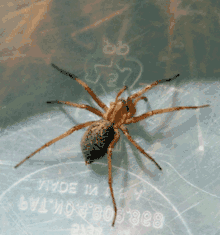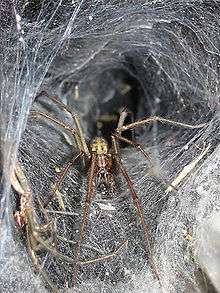House spider
The name house spider is a generic term for different spiders commonly found around human dwellings, and may refer to:
- Yellow sac spider, Chiracanthium inclusum, a common house spider worldwide.
- Black house spider, Badumna Insignis, an Australian spider also found in New Zealand;
- Brown house spider, Steatoda grossa, a spider with cosmopolitan distribution;
- American house spider, Parasteatoda tepidariorum, a cobweb spider;
- Common cellar spider, of the family Pholcidae, also known as daddy long-legs in North America;
- Domestic house spider, Tegenaria domestica, also known as barn weaver in North America;
- Giant house spider, Eratigena atrica (formerly Tegenaria gigantea);
- Hobo spider, Eratigena agrestis (sometimes called aggressive house spider);
- Geometric House Spider or House button spider, Latrodectus Geometricus (more commonly known as the brown widow);
- Southern house spider, Kukulcania hibernalis
- Tiny house spider, Oonops domesticus
Disambiguation gallery
 Yellow Sac spider, Chiracanthium inclusum, a common house spider worldwide
Yellow Sac spider, Chiracanthium inclusum, a common house spider worldwide Black house spider, Badumna Insignis, an Australian spider also found in New Zealand
Black house spider, Badumna Insignis, an Australian spider also found in New Zealand- American house spider, Parasteatoda tepidariorum, a cobweb spider
 Brown house spider, Steatoda grossa, a spider with cosmopolitan distribution
Brown house spider, Steatoda grossa, a spider with cosmopolitan distribution- Southern house spider, Kukulcania hibernalis
 Hobo spider, Tegenaria agrestis (sometimes called aggressive house spider)
Hobo spider, Tegenaria agrestis (sometimes called aggressive house spider) Domestic house spider, Tegenaria domestica
Domestic house spider, Tegenaria domestica Daddy long-legs spiders, of the family Pholcidae
Daddy long-legs spiders, of the family Pholcidae Giant house spider, Eratigena atrica (formerly Tegenaria gigantea)
Giant house spider, Eratigena atrica (formerly Tegenaria gigantea)
gollark: This is why you are to use osmarkslibc™, see.
gollark: These are used to initialize the JS interpreter we use to manage IO, because asynchronous node.jsous IO is cool and trendy.
gollark: osmarkslibc™ is more modern, and includes several JSON files in the binary.
gollark: As opposed to the better osmarkslibc™.
gollark: C is *approximately* JSON.
This article is issued from Wikipedia. The text is licensed under Creative Commons - Attribution - Sharealike. Additional terms may apply for the media files.